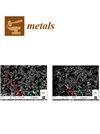Study on the Optimization of the Tensile Properties of an Al-Li Alloy Friction Stir-Welding T-Joint
IF 2.5
3区 材料科学
Q3 MATERIALS SCIENCE, MULTIDISCIPLINARY
引用次数: 0
Abstract
The softening of aluminum–lithium alloy welded joints generally leads to a reduction in mechanical properties. In this study, a piece of 2A97-T3 aluminum–lithium alloy with a thickness of 2.8 mm was selected as the test material, and the tool and process used for wire-filled stationary shoulder friction stir welding (SSFSW) were developed. By increasing the bearing area of the softening zone, an equal-strength T-joint was manufactured. Good weld formation was obtained when the rotation speed was set to 2000 rpm and the welding speed ranged from 100 to 120 mm/min. The thickness of the softening zone was controlled by adjusting the reserved gap between the shoulder and the workpiece. The softening mechanism of the weld joint was revealed. The softening was attributed to the coarsening of the main precipitated phases (T1 and θ′ phases) in the heat-affected zone (HAZ) and the dissolution of precipitated phases in the thermo-mechanically affected zone (TMAZ). Grain refinement in the nugget zone (NZ) led to a certain fine-grained strengthening effect, although the precipitated phase was almost completely dissolved. Due to the thermal effect of second-pass welding, the hardness value of the NZ and HAZ in the center of the skin further decreased, and the minimum hardness was approximately 70% that of the base material. Tensile testing results indicated that the softening effect was largely offset by the increased bearing area of the softening zone, resulting in the successful welding of high-strength Al-Li alloy T-joints with equal strength. The strength coefficient was found to be 0.977.铝锂合金摩擦搅拌焊接 T 型接头拉伸性能优化研究
铝锂合金焊接接头的软化通常会导致机械性能下降。本研究选择了一块厚度为 2.8 毫米的 2A97-T3 铝锂合金作为试验材料,并开发了用于填丝固定肩搅拌摩擦焊(SSFSW)的工具和工艺。通过增加软化区的承载面积,制造出了等强度的 T 形接头。当转速设定为 2000 rpm,焊接速度为 100 至 120 mm/min 时,焊缝成形良好。软化区的厚度可通过调整肩部与工件之间的预留间隙来控制。结果揭示了焊点的软化机理。软化归因于热影响区(HAZ)中主要析出相(T1 和 θ′相)的粗化和热机械影响区(TMAZ)中析出相的溶解。虽然析出相几乎完全溶解,但金块区(NZ)的晶粒细化产生了一定的细粒强化效应。由于二次焊接的热效应,NZ 和蒙皮中心 HAZ 的硬度值进一步降低,最低硬度约为母材的 70%。拉伸测试结果表明,软化效应在很大程度上被软化区增大的承载面积所抵消,从而成功焊接出了具有同等强度的高强度铝锂合金 T 型接头。强度系数为 0.977。
本文章由计算机程序翻译,如有差异,请以英文原文为准。
求助全文
约1分钟内获得全文
求助全文
来源期刊

Metals
MATERIALS SCIENCE, MULTIDISCIPLINARY-METALLURGY & METALLURGICAL ENGINEERING
CiteScore
4.90
自引率
13.80%
发文量
1832
审稿时长
1.5 months
期刊介绍:
Metals (ISSN 2075-4701) is an open access journal of related scientific research and technology development. It publishes reviews, regular research papers (articles) and short communications. Our aim is to encourage scientists to publish their experimental and theoretical results in as much detail as possible. Therefore, there is no restriction on the length of the papers. The full experimental details must be provided so that the results can be reproduced. Metals provides a forum for publishing papers which advance the in-depth understanding of the relationship between the structure, the properties or the functions of all kinds of metals.
 求助内容:
求助内容: 应助结果提醒方式:
应助结果提醒方式:


